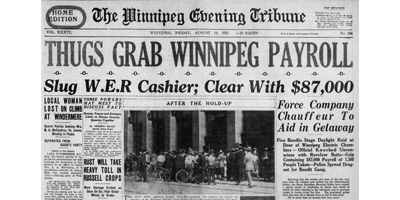by Bruce Cherney (part 4 of 4)
Winnipeg police speculated that the $87,000 robbery of the Winnipeg Electric Company (WECo) payroll was committed by members of an international gang of organized criminals who three years earlier had raided the U.S. Mint at Denver, Colorado, and stole $200,000, and that same year in 1922 carried out the daring $75,000 theft of the civic payroll in Vancouver, B.C.
During the latter robbery, three bandits waylaid two unarmed clerks on the street just outside city hall as they were delivering the city employees’ payroll. One of the clerks took off with the cash, but was overtaken and knocked down, the money bag was seized and then thrown into an automobile the robbers used to flee the scene. Three shots were fired by the bandits as warnings to bystanders to keep their distance. Ironically, one bullet passed through the windshield of their own getaway car, a 1920 Hudson (Vancouver Daily World, September 29, 1922).
The robbers later ditched the rented getaway car by driving it over a cliff at Point Grey, and then they disappeared.
There were obvious similarities between the thefts in Vancouver and Winnipeg: the crimes were well planned, both were daring daylight robberies in the downtown of each city with many bystanders present, a significant amount of money was stolen, the payrolls were taken while being carried into a building, the individual in each case carrying the payroll was savagely attacked, and the getaway vehicles were abandoned soon after the criminals fled the scene.
Two important differences between the two thefts is that in Winnipeg no shots were fired and most passers-by were unaware that a robbery was taking place.
It’s doubtful any the men who took the Vancouver civic payroll were involved in the Winnipeg robbery. Their alleged leader, Albert “Ted” Hollywood, along with three other men, was arrested in 1923 in Bellingham, Washington, for auto theft. Hollywood, who was from Kansas City, received a four-year jail term. He was implicated in a number of robberies, including the one in Vancouver and others in San Francisco and Springfield, Missouri, as well as the Denver mint job.
Hollywood, alias C.C. Thompson, was extradited to Vancouver from Walla Walla State Prison in Washington in April 1925 and received a 26-year sentence. He could not have been serving time in a Canadian prison and also rob the WECo payroll on August 14, 1925, although it’s possible — though unlikely — that some of his past criminal associates took part in the Winnipeg robbery. Most of his known criminal associates were already serving time in various U.S. prisons when the WECo payroll was taken.
Two weeks after the robbery, the whereabouts of the bandits was still unknown, so the Canadian Surety Company, which was on the hook for the insurance claim by the WECo, offered a $15,000 reward for information leading to the arrest and conviction of the robbers. The full reward would be given provided that all the cash stolen was recovered.
To complicate matters, the robbery was so skillfully undertaken that police still lacked an accurate description of the perpetrators, according to the August 31 Tribune.
The insurance company did pay out the full amount of $87,478.18 lost to the electric company in the robbery.
“Had only one guard been on hand the company would have received only $65,000, the limit of liability of the surety firm under the contract,” reported the September 9, 1925, Tribune.
The two guards were Leslie Montgomery and Sydney Knowler, while Richard Shaw, who carried the payroll in a satchel, was employed by the WECo as an assistant cashier. If Knowler had left before the robbery occurred — he was in the process of leaving when a bandit leaped into his vehicle — only one guard would have been present and the insurance company would have paid out some $25,000 less than the WECo eventually received.
The bandits who took $15,000 from the Manitoba Liquor Commission on December 17, 1925, were said to match the descriptions of the electric company robbers and used virtually the same technique for their stick-up. But in the liquor commission theft only two men — not five — were seen to be involved in the robbery and witnesses reported that the same two men abandoned the stolen vehicle they used in their getaway.
When the two bandits entered the MLC, one of them struck Thomas Nuttal, an MLC cashier, who was leaving the building for the bank to deposit the day’s receipts, with an iron pipe wrapped in a newspaper and grabbed the cash.
Before they got away, Nuttal was able to fire several bullets at the car, one of which narrowly missed the driver and his companion.
The police eventually concluded that the MLC was unrelated to the WECo robbery. It was reported in the December 28 Tribune that the police believed the WECo robbery was perpetrated by a gang from either Chicago or St. Paul, while the MLC robbery was claimed by police to have been committed by local crooks operating out of the North End.
As was the case in the unsolved WECo robbery, the loss incurred by the MLC was covered by an insurance, so the company’s agents, Oldfield, Kirby and Gardner, handed over a $15,000 cheque to the liquor commission. The insurer had conceded that the MLC robbers would escape justice. In fact, unlike in the WECo’s case, a reward was not even offered for information leading to the capture and conviction of the two bandits.
With no other leads and the insurance payment already made to the WECo, the case was also effectively closed. The gang got away with the cash and its five members were never caught.



